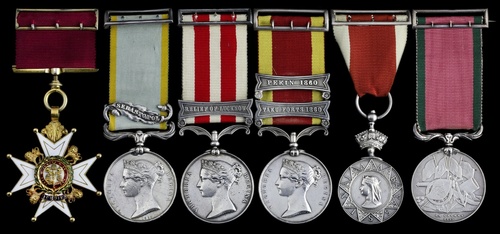
Auction: 19001 - Orders, Decorations and Medals
Lot: 384
(x) The impressive group of six to Colonel John Sydney Hand, C.B., 44th Foot, late 82nd Foot and 1st Sikh Cavalry; after serving with the 82nd at the Siege of Sebastopol, Hand followed the Regiment to the Indian Mutiny, participating in the Second Relief of Lucknow.
During the Second China War he commanded a squadron of the 1st Sikh Cavalry, engaged in the capture of the Taku Forts. In the 1867 Abyssinian campaign General Napier appointed him Director of the Highland Transport Train, a difficult role in such hostile terrain. For his services he was made a Companion of the Bath.
The Most Honourable Order of the Bath, C.B. (Military) Companion's breast Badge, gold (18 carat) and enamel, hallmarks for Robert Garrard, London 1869, fitted with a narrow swivel-ring suspension and a silver-gilt top riband buckle; Crimea 1854-56, 1 clasp, Sebastopol (Lieutt. I. S. Hand 82nd Regt.), officially impressed, fitted with a silver top riband buckle; Indian Mutiny 1857-9, 1 clasp, Relief of Lucknow (Lieutt. I. S. Hand 82nd Regt.), fitted with a Flavelle silver top riband buckle; China 1860, 2 clasps, Taku Forts 1860, Pekin 1860 (Lieutt. I. S. Hand 1st Sikh Cavy.), fitted with a silver top riband buckle; Abyssinia 1867 (Capt. J. S. Hand, 82. Regt.), fitted with a silver top riband buckle; Turkish Crimea, Sardinian issue, replacement scroll suspension, fitted with a silver top riband buckle, the first extremely fine, the second and third with heavy contact marks, generally nearly very fine and better (6)
C.B. London Gazette 21 June 1887.
John Sydney Hand purchased his Ensigncy in the 82nd Foot (Prince of Wales's Volunteers) on 13 May 1853, advancing to Lieutenant on 18 August 1854. He disembarked with the Regiment at Balaklava Harbour on 2 September 1855. Three days later the final Allied bombardment of Sebastopol began. For 72 hours, 800 Allied guns fired 13,000 shells and 90,000 round shot at the Russian defences (see Pemberton 1962, 214). Though the British failed to capture the Redan in the final assault on 8 September, General MacMahon's Zoaves rushed into the Malakoff redoubt and planted the tricolour on its ramparts. That night, the Russians abandoned the southern part of the city, retreating over a bridge of boats hastily thrown across Sebastopol Harbour. After a sanguinary twelve months, the siege was over. Hostilities ended with the Treaty of Paris on 30 March 1856, the 82nd returning home that August.
On the other side of the world, the Chinese, resenting European incursions, seized a ship named Arrow which bore a British flag. The 82nd duly sailed for Hong Kong, but were diverted en route at Singapore in June 1857, having received news of the sepoy mutiny. The 82nd arrived at Calcutta in October, by which time Delhi had been recaptured. The Regiment joined the force being assembled by Sir Colin Campbell for the Second Relief of Lucknow, reaching Cawnpore in early November. Two companies marched on to Lucknow, while the remainder was left to defend Cawnpore's vital bridge and supply dumps. Hand took part in the Second Relief of Lucknow (clasp). During that memorable action, the 82nd captured a huge ceremonial staff, made of chased Indian silver. Nicknamed 'The Rajah's Bedpost', it became one of the Regiment's most treasured possessions. It is now held in the Lancashire Infantry Museum.
The 82nd Regiment were then heavily engaged in Oudh and Rohilkund provinces. In February 1858, a Company was trained to use the artillery at Fort Fatehgarh, covering the fords across the Ganges north of Cawnpore. In April, four Companies took part in the victory at Bareilly, the capital of Rohilkund. In May, one wing of the Battalion joined a small force which marched for days in blazing heat to rescue British troops besieged in Shahajanpore. Men died of sunstroke. The 82nd were engaged in countless other minor actions before peace returned to the Indian subcontinent.
Hand commanded a Squadron of the 1st Sikh Cavalry during the Second China War of 1860. He was present at Sinho, the capture of the Taku Forts, the advance on Pekin and the destruction of the Emperor's Palace. He was promoted to Captain on 16 November 1860. During the Abyssinian campaign of 1868 he served with the rank of Brevet Major, and was attached to Napier's Headquarters as Director of the Highland Transport Train. He was present at the storming and capture of Magdala on 13 April, and twice mentioned in Napier's despatches (London Gazette, 30 June 1868). He transferred to the 44th (East Essex) Regiment of Foot in December 1872, rising to become Lieutenant-Colonel and Honorary Colonel (London Gazette, 27 October 1876). In the 1887 Golden Jubilee Honours he was made a Companion of the Bath; sold with copied research and London Gazette entries.
Subject to 5% tax on Hammer Price in addition to 20% VAT on Buyer’s Premium. For more information please view Terms and Conditions for Buyers.
Sold for
£3,800




